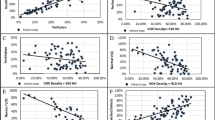Abstract.
Ventilation/perfusion scans with single-photon emission tomography (SPET) were reviewed to determine their usefulness in the evaluation of lung volume reduction surgery (LVRS) candidates, and as a predictor of outcome after surgery. Fifty consecutive planar ventilation (99mTc-DTPA aerosol) and perfusion (99mTc-MAA) scans with perfusion SPET of patients evaluated for LVRS were retrospectively reviewed. Technical quality and the severity and extent of radiotracer defects in the upper and lower halves of the lungs were scored from visual inspection of planar scans and SPET data separately. An emphysema index (EI) (extent × severity) for the upper and lower halves of the lung, and an EI ratio for upper to lower lung were calculated for both planar and SPET scans. The ratios were compared with post-LVRS outcomes, 3, 6 and 12 months after surgery. All perfusion and SPET images were technically adequate. Forty-six percent of ventilation scans were not technically adequate due to central airway tracer deposition. Severity, extent, EI scores and EI ratios between perfusion and SPET were in good agreement (r = 0.52–0.68). The mean perfusion EI ratio was significantly different between the 30 patients undergoing biapical LVRS and the 17 patients excluded from LVRS (3.3±1.8 versus 1.2±0.7; P<0.0001), in keeping with the anatomic distribution of emphysema by which patients were selected for surgery by computed tomography (CT). The perfusion EI ratio correlated moderately with the change in FEV1 at 3 months (r = 0.37, P = 0.04), 6 months (r = 0.36, P = 0.05), and 12 months (r = 0.42, P = 0.03), and the transition dyspnea index at 6 months (r = 0.48, P = 0.014) after LVRS. It is concluded that patients selected to undergo LVRS have more severe and extensive apical perfusion deficits than patients not selected for LVRS, based on CT determination. SPET after aerosol V/Q imaging does not add significantly to planar perfusion scans. Aerosol DTPA ventilation scans are not consistently useful. Perfusion lung scanning may be useful in selecting patients with successful outcomes after LVRS.
Similar content being viewed by others
Author information
Authors and Affiliations
Additional information
Received 9 October 1998 and in revised form 31 January 1999
Rights and permissions
About this article
Cite this article
Jamadar, D., Kazerooni, E., Martinez, F. et al. Semi-quantitative ventilation/perfusion scintigraphy and single-photon emission tomography for evaluation of lung volume reduction surgery candidates: description and prediction of clinical outcome. Eur J Nucl Med 26, 734–742 (1999). https://doi.org/10.1007/s002590050444
Issue Date:
DOI: https://doi.org/10.1007/s002590050444




